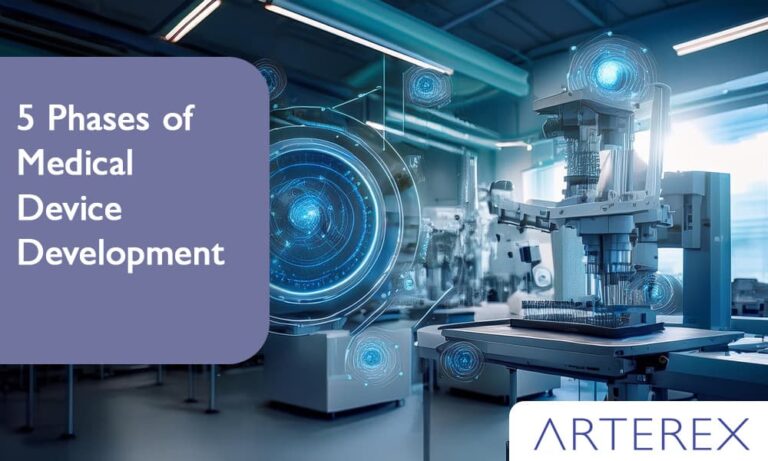5 Phases of Medical Device Development
Written by
Arterex Medical
Published on
September 6, 2024
Read time
10 minute read
Medical device development is a highly intricate process, governed by increasingly stringent regulations that must be met to secure FDA approval or comply with the EU Medical Device Regulation (MDR). Each phase in this lifecycle is distinct, designed to ensure stringent design control, which guarantees that the device is both safe and effective for use.

The development process consists of five essential phases that collectively form the basis of the Quality System Regulation (QSR). These phases guide the design, manufacturing, packaging, labeling, storage, installation, and servicing of medical devices intended for human use. Adhering to the QSR ensures that the product meets the necessary standards for market entry.
The five phases outlined by the FDA are as follows:
- Device Discovery and Concept
- Preclinical Research and Prototyping
- Pathway to Approval
- FDA Review
- FDA Post-Market Safety Monitoring
On the other hand, the EU MDR takes a slightly different approach. While it doesn’t specifically outline individual articles for design or manufacturing, the manufacturer’s primary responsibility, as described in Article 10.1, is to design and manufacture devices in compliance with the regulation. The design and manufacturing obligations are embedded within the quality management system requirements found in Article 10, section 9, which states:
“The quality management system shall address… (g) product realization, including planning, design, development, production, and service provision.”
This requirement aligns closely with Section 7 of the harmonized Standard EN ISO 13485:2016, titled “Medical Devices – Quality Management Systems – Requirements for Regulatory Purposes,” which provides detailed guidance on design, development, production, and service provision.
Moreover, several other standards are integral at various steps of the medical device development cycle. These standards are widely used and ensure that the development process adheres to international guidelines, making it compliant with both FDA and EU MDR regulations.
Development Steps and Related Standards
Each step or process in medical device development must adhere to specific international standards and regulatory requirements to ensure safety, effectiveness, and compliance. Here’s a breakdown of what these standards represent:
Quality System:
Ensures quality management for the design and manufacturing process.
Standards:
- ISO 13485:2016: Specifies requirements for a quality management system specific to medical devices.
- FDA 21 CFR part 820: The FDA’s quality system regulation for medical devices in the U.S.
Risk Management
ISO 14971: Specifies a process for risk management for medical devices, covering identification, evaluation, and control of risks.
Human Factors
IEC 62366: Focuses on usability engineering to ensure that the medical device can be used safely by humans.
Medical Device Standards
IEC 60601: Specifies safety and performance requirements for electrical medical devices.
Software Lifecycle
IEC 62304: Defines the processes for the development and maintenance of medical device software.
Regulatory Requirements
Different countries and regions have specific regulatory bodies and requirements, such as:
FDA (U.S.), Health Canada, MDD (EU Medical Device Directive), CFDA (China Food and Drug Administration), PMDA (Japan’s Pharmaceuticals and Medical Devices Agency).
Clinical Trial Management
- ISO 14155: Good clinical practice guidelines for conducting clinical trials with medical devices.
Additionally, standards exist for areas such as sterilization, packaging, shipping, and labeling to ensure proper handling of the devices throughout their lifecycle.
These standards are crucial for ensuring that medical devices are safe, effective, and meet regulatory requirements globall
Initial Design and Development Plan

The first phase of medical device development is critical as it lays the foundation for the entire project. It involves creating an initial design and development plan that outlines the device’s intended use and the steps needed to bring it to market. The primary objectives in this phase include:
- Defining Intended Use: Clearly articulate the purpose of the device and its intended user. This involves understanding the clinical need the device will address and how it will improve patient outcomes.
- Market Research: Analyze existing products in the market to identify similarities, differences, and potential gaps. This helps in differentiating the new device and positioning it effectively.
- Consumer Demands: Gather and analyze data on user needs and preferences. This information is crucial for designing a device that meets user expectations and complies with regulatory requirements.
- Design Inputs: Collect inputs from various sources, including user needs, regulatory guidelines, and technical requirements. These inputs form the basis for the design process and ensure that all critical aspects are considered.
Risk and Benefit Analysis
Risk and benefit analysis is an ongoing process that begins in the initial phase and continues throughout the device’s lifecycle. The primary steps include:
- Identifying Risks: Assess potential risks associated with the device, such as safety concerns, performance issues, and usability problems. Consider risks related to both the device’s use and its manufacturing process.
- Evaluating Benefits: Determine the benefits of the device, including its potential impact on patient health, ease of use, and overall effectiveness.
Risk Management Plan: Develop a risk management plan in accordance with ISO 14971. This plan should outline the scope of risk management activities, including design, development, production, and post-market monitoring.
Design and Development Plan
Creating a comprehensive design and development plan involves several key steps:
- Initial Design: Start with preliminary design concepts and prototypes. This stage includes sketching, computer-aided design (CAD) modeling, and initial testing.
- Design Review: Conduct design reviews to assess the feasibility and effectiveness of the initial design. Gather feedback from stakeholders and make necessary adjustments.
- Prototyping: Develop and test prototypes to validate design concepts. This may involve creating multiple prototypes and iterating based on testing results.
User Feedback: Collect feedback from potential users and clinical experts to refine the design and address any issues identified during testing.
Customer Needs
Understanding customer needs is essential for developing a successful medical device. This phase involves:
- Feedback Collection: Use surveys, interviews, and focus groups to gather insights from patients, healthcare providers, and other stakeholders. This feedback helps identify key features and functionalities required in the device.
- Competitor Analysis: Analyze competing products to understand their strengths and weaknesses. This information can help differentiate your device and identify opportunities for innovation.
Feasibility Study

The feasibility study assesses whether the device concept is viable and can be developed into a marketable product. Key activities include:
- Unknown Variables: Identify and address any uncertainties or challenges that could impact the development process. This may involve technical, regulatory, or market-related issues.
- Engineering Design: Begin detailed engineering design work, including selecting materials, components, and manufacturing processes.
- Reliability Testing: Conduct reliability testing to evaluate the performance and durability of the device. This may involve stress testing, life-cycle testing, and other assessments.
Manufacturer Audits: Evaluate potential manufacturers to ensure they meet quality and regulatory standards. Review their certifications, processes, and capabilities.
Refined Design Plan
As the device concept becomes clearer, update the design and development plan to reflect new information and requirements:
- Work Requirements: Identify remaining tasks and milestones. This includes design refinements, prototyping, and testing.
- Requirements Verification: Ensure that all regulatory, user, and technical requirements are documented and addressed.
Notified Body Review: Consider sharing the updated plan with a Notified Body (in the EU) or regulatory agency for preliminary feedback.
Phase 3: Design and Development – Verification and Validation
Design Outputs
Design outputs include all documentation and artifacts produced during the design process. This may include:
- Product Drawings: Detailed drawings and specifications of the device components and assemblies.
- Specifications: Technical specifications for materials, components, and performance.
- Prototypes: Functional prototypes used for testing and validation.
Design and Prototyping Process
The design and prototyping process involves several critical activities:
- Prototype Testing: Evaluate prototypes to ensure they meet design inputs and user needs. Conduct performance, safety, and usability tests.
- Design Validation: Validate the design by comparing it against user needs and regulatory requirements. This includes clinical evaluations and other forms of validation.
Clinical Trials: If required, initiate clinical trials to assess the device’s safety and efficacy in a real-world setting.
Verification of Design Outputs vs. Inputs
Verification involves ensuring that the design outputs align with the design inputs. Key steps include:
- Testing Protocols: Develop and execute testing protocols to verify that the device meets all specified requirements.
- Traceability: Establish traceability to ensure that all design inputs are addressed and validated through testing.
Risk and Benefit Updates: Continuously update the risk and benefit analysis based on test results and feedback.
Operational and Performance Qualification
Prepare for market introduction by completing operational and performance qualification:
- Pilot Runs: Conduct small-scale manufacturing pilot runs to validate the production process. Collect data on process capability and quality.
- Critical-to-Quality Attributes: Identify and control critical attributes to ensure consistent product quality during mass production.
- Process Control: Implement measures to maintain process control, including equipment maintenance and staff training.
Technical Documentation
Prepare and submit comprehensive technical documentation for regulatory review:
- Validation Reports: Include evidence of validation activities, such as biocompatibility testing, electrical safety, and stability testing.
- Technical File: Compile all relevant documents, including design history, risk management files, and clinical data.
Regulatory Submission: Submit the technical file to the appropriate regulatory authority for review and approval. This may involve a Notified Body (in the EU) or the FDA.
Risk and Benefit Analysis (Updated)
Conduct a final review of the risk and benefit analysis before market release:
- Residual Risk: Ensure that the residual risk is acceptable and that risk management systems are in place for ongoing monitoring.
Post-Market Monitoring: Develop a plan for post-market surveillance to track the device’s performance and address any issues that arise.
Production and Market Introduction
Once the device is approved, focus on production and market introduction:
- Validated Production Plan: Implement a validated production plan to ensure timely and high-quality product delivery.
Regulatory Compliance: Continue to verify that production processes and quality management systems comply with regulatory requirements.
Post-Market Activities
Engage in post-market activities to monitor and improve the device’s performance:
- Post-Market Surveillance: Collect and analyze data from users, patients, and other stakeholders to monitor the device’s safety and efficacy.
- Customer Documentation: Provide users with necessary documents, such as instructions for use (IFUs), user guides, and training materials.
- eQMS Tools: Use electronic Quality Management Systems (eQMS) to track customer complaints, product recalls, and other post-market activities.
Continuous Improvement: Implement a cycle of continuous improvement to address issues and enhance the device based on real-world feedback.
Conclusion
The development of a medical device is a complex and regulated process that requires careful planning, execution, and ongoing management. By following the five phases outlined above—Device Discovery and Risk Analysis, Formulation, Concept, and Feasibility, Design and Development, Final Validation and Product Launch Preparation, and Production, Market Introduction, and Post-Market Follow-Up—developers can navigate the challenges and ensure that their products meet regulatory standards and user needs.
The use of advanced tools and systems, such as electronic Quality Management Systems (eQMS), plays a crucial role in streamlining the development process and maintaining compliance. These systems help manage documentation, track progress, and facilitate communication with regulatory authorities.
By adhering to best practices and maintaining a focus on safety, efficacy, and regulatory compliance, medical device developers can successfully bring innovative and high-quality products to market, ultimately improving patient outcomes and advancing healthcare.
